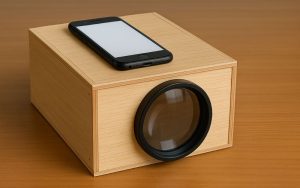Nothing says strong quite like concrete. So if you want a really durable, knock-over-proof bench for your garden then a concrete one is the answer! This DIY concrete garden bench would be a great addition to any yard for its simplicity.
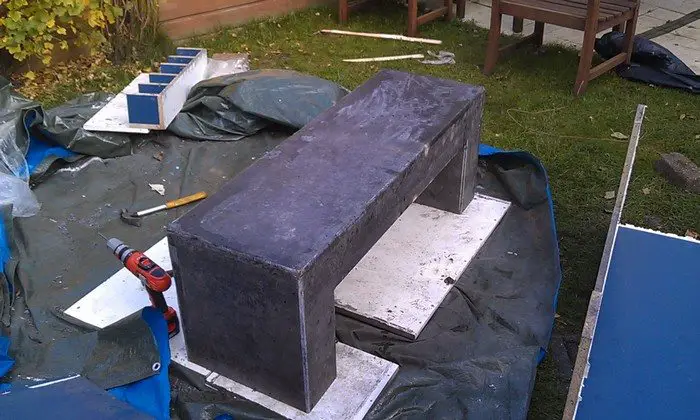
It’s quite a big concrete project, but it’s easy even to those who have never built anything using concrete!
When finished, this garden bench will weigh around 250 kg. It’s really heavy and will almost be impossible to move on your own. So make sure to do this project very near the site where it would be placed!
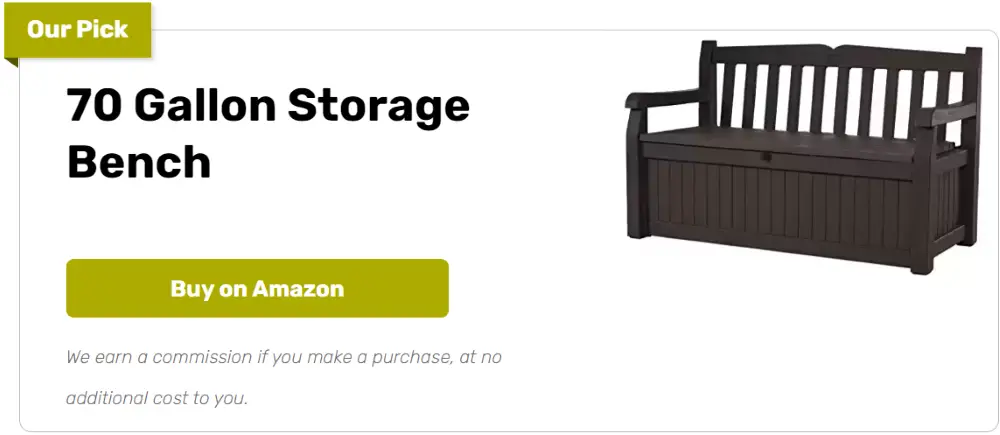
However, you can also do this project a little differently if you want to get rid of some of the weight. You could use polystyrene or PVC pipes as fillers. You can also go for lightweight concrete that’s readily available in most hardware stores. This would make your bench 25% lighter. Or you can build a ‘thinner’ version of it if you want to make it look lightweight.
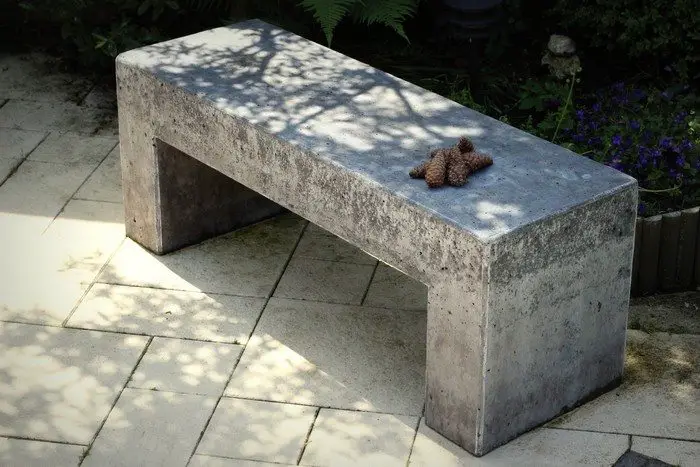
But ultimately you need to determine the maximum load that you want your bench to support. This is so that you will know what materials can and cannot be used in your DIY project. If you’re unsure, you can do some research or consult a knowledgeable friend! ;)
Do you want a concrete garden bench for your outdoor area?
Learn how to build one now through the step-by-step tutorial below!
Click on any image to start the lightbox display. Use your Esc key to close the lightbox ![]()



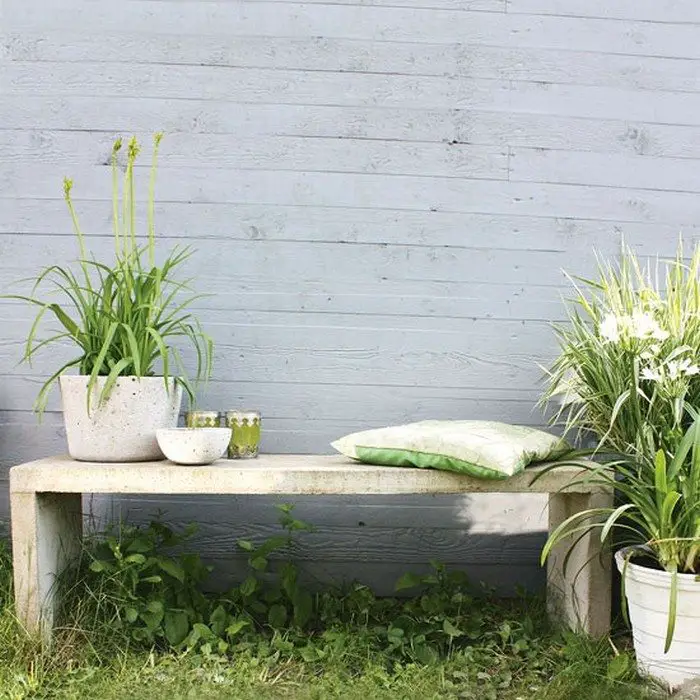
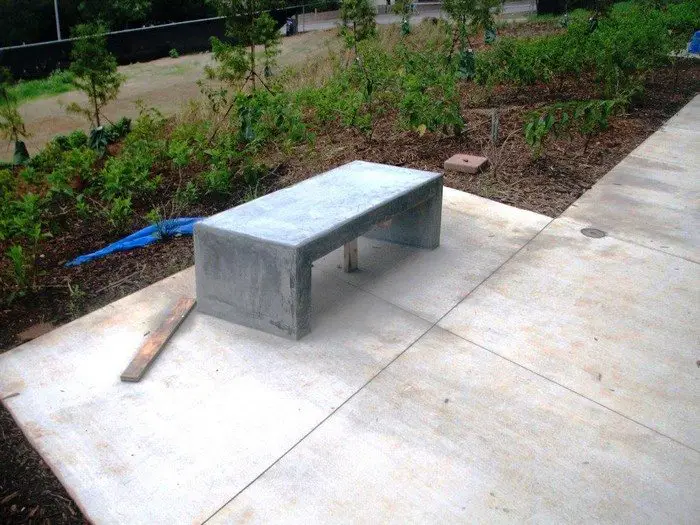
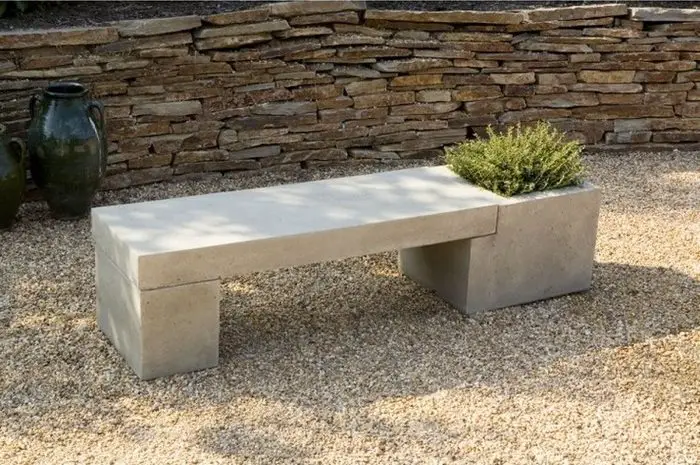
You’ll need these materials:
- Melamine Board / Shuttering Plywood
- Concrete
- Screws
- Silicon Sealant
- Release Agent (Silicone Spray, Petroleum Jelly, WD40)
- Masking tape
- Rebar
- Scrap Wood
- Rope
- Concrete Coloring (optional)
And these tools:
- Power Drill
- Caulking Gun
- Old Orbital Sander
- Mixing Bucket
- Shovel
- Hammer
Steps:
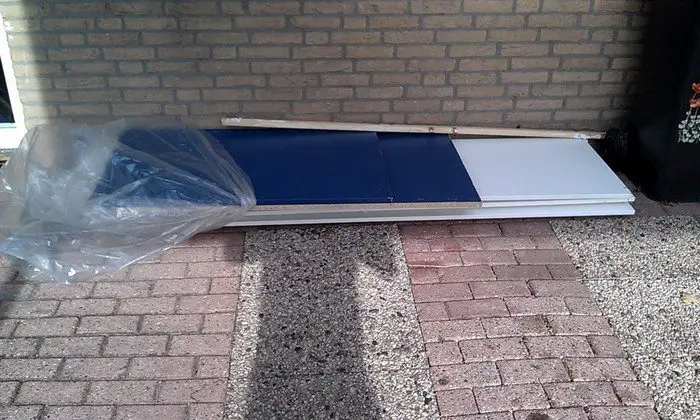
On materials:
1. Melamine Board or Shuttering Plywood
To make your concrete garden bench mold, you’ll need a waterproof plywood with a smooth surface. Shuttering plywood is a material that’s designed to make molds. It’s got a very smooth surface and is water resistant. It’s also very expensive. When you are planning on reusing the mold I will recommend shuttering plywood. Otherwise melamine board is a cheap alternative.
A melamine board has a smooth surface, but it’s not water resistant at the sides. I found an old closet in the dumpster and reused its boards to construct my mold.
2. Concrete
I used 10 premixed concrete bags (25kg each) as they are easy to use. When you want to make your own concrete you have to put the cement, sand and gravel together. 1 part cement, 2 parts sand and 3 parts gravel. When you change the size of the bench you have to calculate the amount of concrete you need. A 25kg bag of concrete is good for 12 liters.
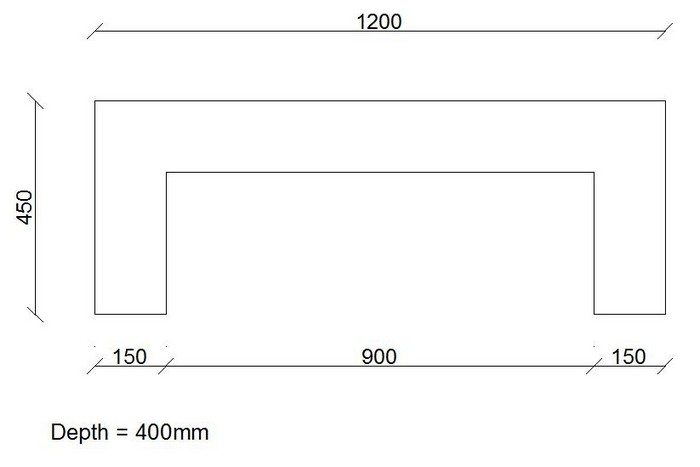 Making the mold: The cutting of the concrete garden bench pieces was done by my local hardware store. When everything fits correctly it’s really easy to screw together.
Making the mold: The cutting of the concrete garden bench pieces was done by my local hardware store. When everything fits correctly it’s really easy to screw together.

The cutout of the concrete garden bench was made with a circular saw. Place the two sidepieces on top of each other and clamp them down before cutting. Doing this you will get two identical pieces.
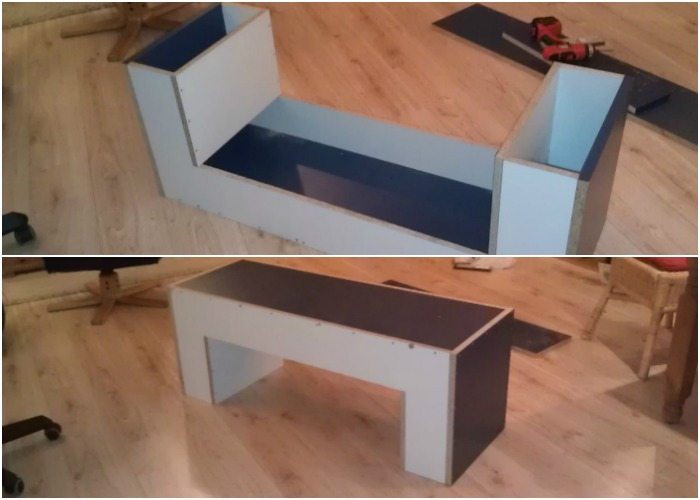
You can now screw everything together. Be sure to use a lot of screws because it has to be able to withstand the weight of the concrete.

Adding rebar: I used a piece of an old fence to function as rebar. I cut it down to the correct size with an angle grinder. You can also buy rebars at your local hardware store.
While making and placing the rebar you have to consider two things:
- You have to place the rebar with an offset of at least 4 cm from the concrete surface. If you don’t do this, the rebar can rust and you can get spalled concrete. When you want to place your rebar closer to the surface you can use a coated rebar or stainless steel.
- You have to place the rebar as far down in the seat as possible. When you sit on the bench it creates tensile forces in the bottom of the seat. This is the place you want your rebar to be.
I doubt if rebar is really necessary for this particular bench. The seat is 15 cm thick so it should withstand a lot by its own. But it’s better to be safe than sorry.
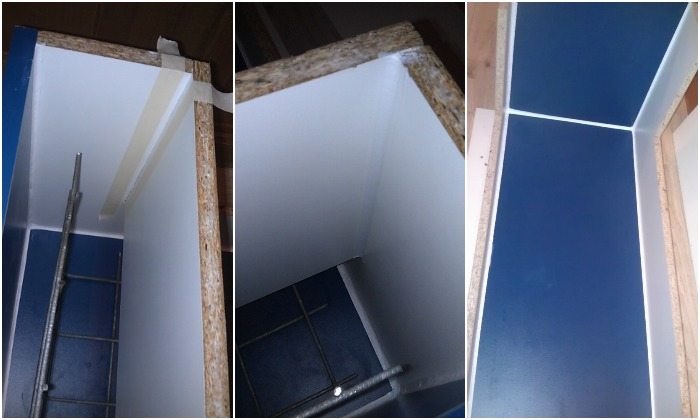
Applying silicone sealant: When using melamine board you have to apply silicone sealant at the joints because the melamine board isn’t waterproof at the joints. The silicone seal also creates a nice round edge. I used masking tape to create a tight seal.
NOTE: Before you seal the inside of the legs you have to place your rebar in!
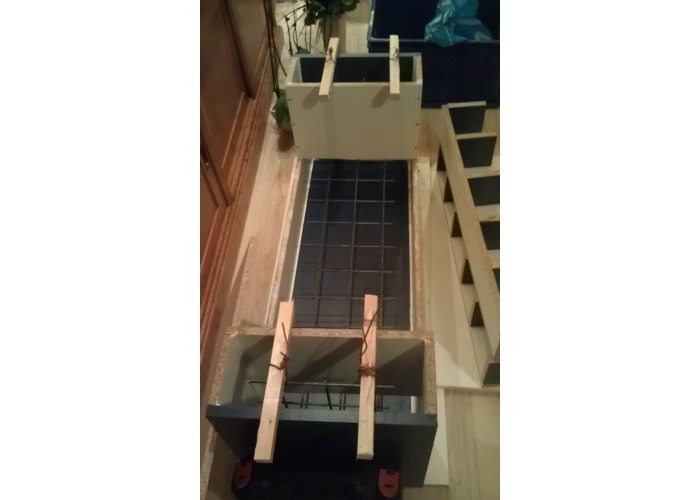
Placing rebar: I placed the rebar with some scrap pieces of wood and some string.
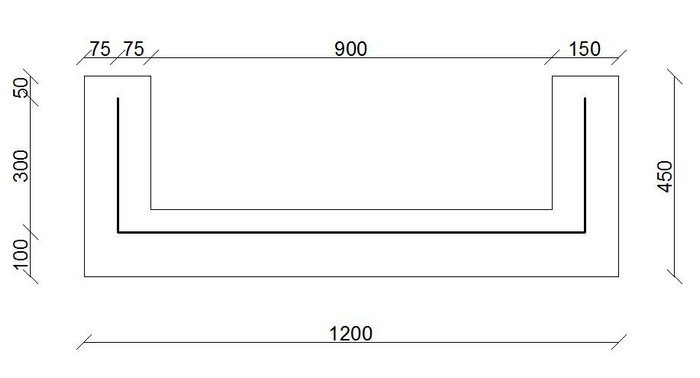
The rebar is placed as shown in the drawing for the concrete garden bench.
Mixing the concrete: Follow the instruction on the bag to mix your concrete. I used a big plastic tub and mixed the concrete and water with a shovel. A good tip is to first calculate the water you need and than add 2/3 of this in the tub. Add your concrete little by little while mixing it. At the end add the other 1/3 of the water.
I used black pigment powder to give the concrete a darker color. I did a shitty job mixing the pigment with the concrete. This is why the concrete has a patchy appearance. But in the end I really liked this.
NOTE: Be sure to wear gloves when mixing concrete for your concrete garden bench. I did not know this and made the mistake of touching the concrete, scooping it in the mold and even mixing the concrete with my bare hands! The cement in the concrete is hydrophillic and will get your hands as dry as dessert sand. My hands were a disaster for three days! Always use gloves folks!
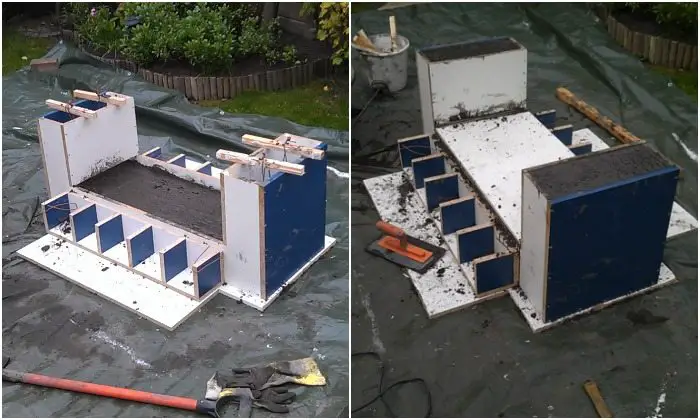
Filling the mold: Before you fill the mold you have to be sure the mold is placed level.
To make the mold easy to come off you have to use a release agent. There are special release agents on the market but it’s not worth the money. I used silicone spray as a release agent. You can also use olive oil, WD40, petroleum jelly, almost anything that’s greasy.
To get a smooth surface you have to get the air bubbles out of the concrete. To do this you have to vibrate the mold, I used two different techniques for this:
– Tap the mold rapidly with a hammer. This is used to get the bottom of the mold smooth (seat part)
– Use an old orbital sander to press against the mold. This is a good method to get the air bubbles out of the legs and sides.
You can also use a drill hammer to vibrate the mold.
Knowing this you can now fill the mold with concrete. Be sure to spread the concrete and press it into the base of the mold. Fill small batches of concrete and tap the mold frequently between the batches. This is really important! Also use the orbital sander on the sides of the bench.
When you have filled the seat of the concrete garden bench you have to put the piece of board in place before you can fill up the legs. When you’re finished filling up the legs, you have to cover the legs with a plastic foil. This is done to prevent the water in the concrete from evaporating.
NOTE: I made extra bracing pieces to strengthen the sides of the concrete garden bench mold although this wasn’t necessary at all.
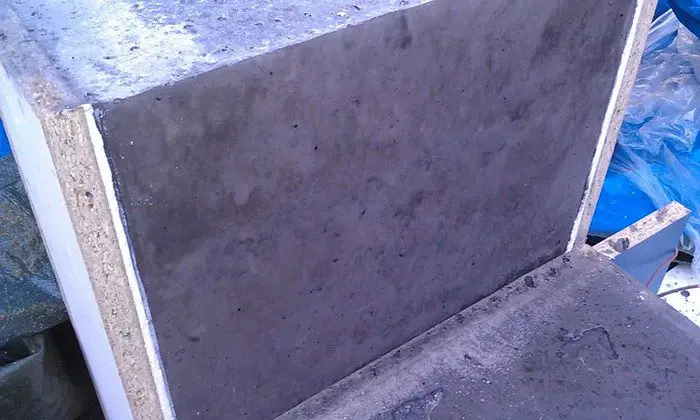
Demolding: When you’ve waited for five days you can start demolding the concrete garden bench. Unscrew the boards and use a joint knife as a wedge between the wood and the concrete.

Final product: You’ve made yourself a nice looking concrete garden bench that will last forever and ever and ever… Good luck with moving the bench. This 250 kg beast is a real back breaker.
Thanks to rubenrijst for this great project!
Contents
Design Variations for Concrete Garden Benches
Explore the endless possibilities of customizing your outdoor space with a concrete garden bench. This versatile piece can transform any garden into a more inviting and stylish environment. Whether you prefer a modern look or something more traditional, there are several design variations to consider for your concrete garden bench.
Curved and Shaped Benches
A curved concrete garden bench can add a soft, organic feel to your garden’s layout. These benches are ideal for encircling a fire pit, tree, or garden feature. Alternatively, geometrically shaped benches, such as triangular or hexagonal, can offer a modern touch and become the focal points of your space.
Integrated Planter Benches
Combine functionality with aesthetics by incorporating planters into your concrete garden bench. This design variation is perfect for those who love gardening and also want to maximize their space. The planters can be used to grow herbs, small flowers, or even succulents, adding a living element to your bench.
Decorative Concrete Garden Benches
Elevate the look of your concrete garden bench by integrating decorative elements. Mosaics made from tiles, colored glass, or stones can be embedded into the bench to create vibrant, unique patterns. Such additions not only enhance the visual appeal but also personalize the space.
Engraved and Stamped Benches
Personalization can be taken a step further with engraved or stamped concrete garden benches. Before the concrete sets, you can stamp it with patterns or engrave it with names, dates, or meaningful quotes. This makes your bench not only a functional piece but also a lasting memory in your garden.
Bench as Art
Consider turning your concrete garden bench into a piece of art. This can be achieved by molding the concrete into imaginative shapes or incorporating artistic elements during the casting process. Such benches serve as both seating and sculptural art, enriching the garden’s aesthetic appeal.
We have more ways to boost your outdoor space aesthetic. Check out our deck building guide!

